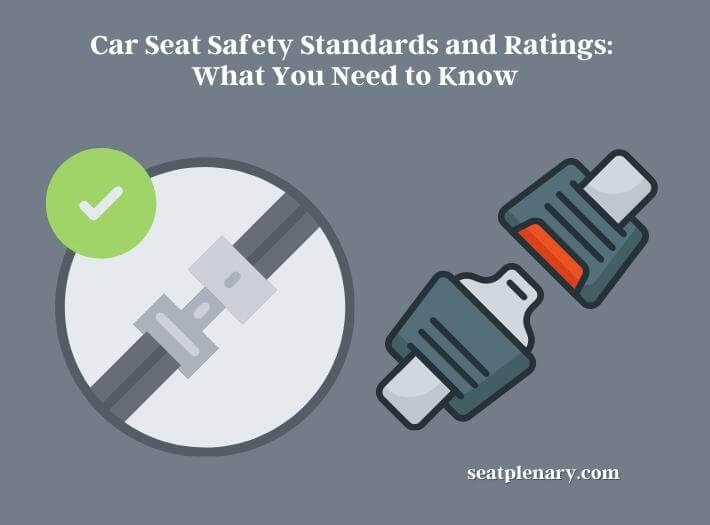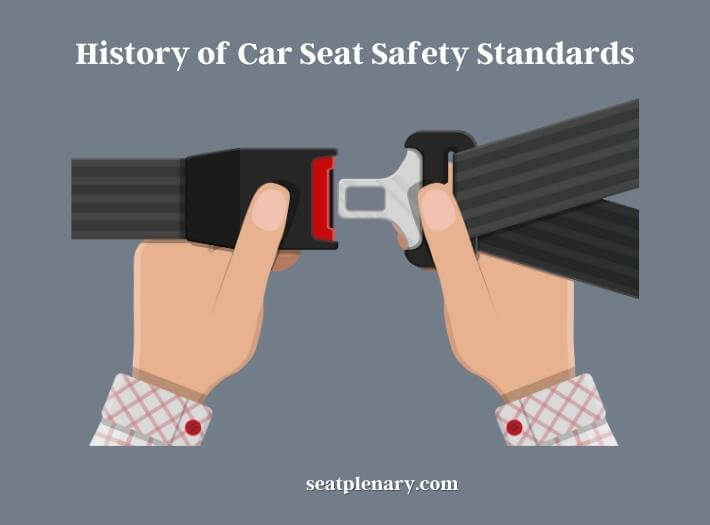Car accidents are a leading cause of injury and death for children, which is why ensuring their safety in a vehicle is of utmost importance. One of the most effective ways to protect children during car rides is by using a properly installed and appropriate car seat. With so many different car seat options available, choosing the right one can be overwhelming for parents.

Car seat safety standards and ratings provide parents with the necessary information to select the appropriate car seat for their child and ensure that the car seat is properly utilized.
These standards and ratings are set by the National Highway Traffic Safety Administration (NHTSA) and provide parents with a trusted source of information to help protect their children.
History of Car Seat Safety Standards
Car seat safety standards have been evolving since the early 20th century when cars first became widely available to the general public. In the beginning, car seats were not designed for safety, but rather for comfort and convenience. The history of car seat safety standards is below.
It wasn’t until the 1960s that safety concerns began to be addressed in the car seat design. In 1962, the first federal safety standard for car seats was introduced in the United States. This standard required that car seats be able to withstand a 20 mph crash without dislodging from the vehicle or injuring the child.
Car seat safety standards continued to evolve as researchers and safety experts learned more about the dangers of car accidents and how to prevent injuries to children. In the 1970s, safety experts began to realize the importance of securing car seats to the vehicle using seat belts, and many states began to require the use of car seats for young children.
In the 1980s, car seat safety standards became more sophisticated, with requirements for headrests, padding, and harness systems. The use of booster seats for older children also became more common during this time.

In the 1990s and 2000s, car seat safety standards continued to improve, with the introduction of side-impact protection, latch systems for securing car seats, and better testing methods to ensure car seats were effective in protecting children in real-world crash scenarios.
Today, car seat safety standards are more advanced than ever, with requirements for rear-facing seats for infants, extended harnessing for toddlers, and booster seats for older children. There are also a wide variety of car seat models available on the market, designed to meet the needs of different families and children.
Seat Safety Standards
Car seat safety standards are regulations and guidelines that are put in place to ensure that car seats meet specific safety requirements. The National Highway Traffic Safety Administration (NHTSA) is the organization responsible for setting the safety standards for car seats in the United States.
Car seats that meet these standards are required to undergo rigorous testing and must meet certain criteria before they can be sold.
Crash Testing
One important aspect of car seat safety standards is crash testing. Car seats must be tested to simulate various types of crashes, including frontal, side-impact, and rear-impact collisions. The car seat must perform well in these crash tests and protect the child from injury.
Age and Weight Guidelines
Another important aspect of car seat safety standards is the requirement for appropriate age and weight guidelines. Car seats are designed for specific age and weight ranges, and parents must choose a car seat that is appropriate for their child’s size and age. This is because different car seats are designed to protect children at different stages of development.
Clear Labeling and Instructions
Car seat safety standards require clear labeling and instructions for installation and use. The instructions should be easy to understand and follow to ensure that the car seat is installed and used correctly.
Car seat safety standards are put in place to ensure that car seats are designed and manufactured with safety in mind. Parents should always choose a car seat that meets these safety standards and guidelines to ensure the safety of their child while on the road.
Car Seat Safety Ratings
Car seat safety ratings can also help parents make informed decisions about which car seat to choose for their child. The two main organizations that provide car seat safety ratings are the National Highway Traffic Safety Administration (NHTSA) and the Insurance Institute for Highway Safety (IIHS).
The NHTSA provides a rating system that evaluates car seats based on their ease of use and how well they protect children in a crash. The rating system uses a five-star rating scale, with five stars being the best rating. The evaluation criteria include how easy it is to install the car seat, how easy it is to secure the child in the car seat, and how well the car seat performs in crash tests.
The IIHS provides a different type of rating system called the “Best Bet” rating. The Best Bet rating is given to car seats that provide a good belt fit for typical 4 to 8-year-olds in almost any car, minivan, or SUV. The IIHS also provides a rating for booster seats that help parents choose the best booster seat for their child.
It’s important to note that car seat safety ratings are not the only factor to consider when choosing a car seat. Parents should also consider the car seat safety standards, their child’s age and weight, and the type of vehicle they have when making their decision.
Car seat safety ratings provide a valuable resource for parents to help them choose a car seat that will keep their children safe in the event of a crash. Parents should always choose a car seat that meets the safety standards and guidelines, and also has a high safety rating.
Choosing the Right Car Seat
Choosing the right car seat for your child is crucial for their safety during car rides. The first step in choosing a car seat is to consider your child’s age and weight. There are several types of car seats available, including rear-facing, forward-facing, and booster seats, and each is designed to protect children at different stages of development.
Infants and Young Children
For infants and young children, a rear-facing car seat is recommended. These car seats are designed to protect children from birth up to about 2 years old, or until they reach the maximum height and weight limit for the car seat. Rear-facing car seats provide the best protection for babies and young children because they support the head, neck, and spine in the event of a crash.
Toddlers and Young Children
For toddlers and young children, a forward-facing car seat is recommended. These car seats are designed to protect children who have outgrown their rear-facing car seats and are at least 2 years old. Forward-facing car seats have a harness system that helps protect the child in the event of a crash.
Older Children
For older children, booster seats are recommended. These car seats are designed for children who have outgrown their forward-facing car seats and are at least 4 years old. Booster seats elevate the child and help position the seat belt correctly to ensure proper fit and protection in the event of a crash.
When choosing a car seat, it’s important to consider the car seat safety standards and ratings, as well as the ease of installation and use.
Installing and Using a Car Seat
Installing and using a car seat correctly is just as important as choosing the right car seat for your child. Improper installation or use can result in serious injury or even death in the event of a crash. Here are some tips for installing and using a car seat correctly:

Read the Car Seat Manual
Every car seat comes with a manual that provides instructions on how to install and use it correctly. Be sure to read the manual carefully and follow the instructions exactly.
Use the Right Installation Method
There are two main installation methods for car seats – the LATCH system and the seat belt. Make sure you choose the right method for your car seat and your vehicle.
Install the Car Seat Tightly
The car seat should be installed tightly with no more than one inch of movement in any direction.
Position the Car Seat Correctly
Rear-facing car seats should be positioned at a 45-degree angle to support the baby’s head, neck, and spine. Forward-facing car seats should be positioned upright.
Use the Harness Correctly
The harness should be snug against the child’s body with the chest clip at the armpit level.
Don’t Add Anything to the Car Seat
Do not add any extra padding or toys to the car seat as they can interfere with the car seat’s safety features.
Register the Car Seat
Register your car seat with the manufacturer so that you can be notified of any recalls or safety issues.
It’s also a good idea to have your car seat installation checked by a certified technician to ensure that it’s installed correctly. Many police stations, fire departments, and hospitals offer free car seat checks.
Benefits of Car Seat Safety Standards and Ratings
Car seat safety standards and ratings are designed to ensure that children are protected from injury or death in the event of a car accident. There are many benefits to having these standards and ratings in place.
Increased Safety
Car seat safety standards and ratings are developed based on research and testing to ensure that they offer the highest level of protection possible for children. By following these guidelines, parents can be confident that their child’s car seat will provide optimal safety in the event of a crash.
Consistency
Car seat safety standards and ratings provide a consistent framework for evaluating the safety of different car seat models. This makes it easier for parents to compare different options and choose the best one for their child.
Improved Quality
By setting safety standards and requiring car seat manufacturers to meet them, the overall quality of car seats has improved. This means that even entry-level car seats are safer than they were in the past.
Awareness
Car seat safety standards and ratings have raised awareness about the importance of using car seats correctly and consistently. This has led to an increase in the number of parents who use car seats and a decrease in the number of injuries and deaths caused by car accidents.
Long-Term Savings
Investing in a high-quality car seat that meets safety standards and ratings can save parents money in the long run. This is because these car seats are designed to last for several years, so parents do not need to replace them as often.
Car seat safety standards and ratings are essential tools for parents who want to ensure the safety of their children while traveling in a car. By choosing a car seat that meets these standards and ratings, parents can rest assured that their child is protected in the event of a car accident.
Conclusion
Car seat safety standards and ratings are essential to consider when choosing a car seat for your child. Choosing the right car seat for your child’s age and weight, as well as following the installation and usage guidelines, are crucial for their safety while on the road.
Remember that car seat safety is an ongoing process that requires regular checks and updates as your child grows and develops. Be sure to follow the recommended guidelines for transitioning from one type of car seat to another as your child grows.
Installing and using a car seat correctly is just as important as choosing the right car seat. Take the time to read the manual, use the right installation method, install the car seat tightly, position it correctly, use the harness correctly, and have your installation checked by a certified technician.
